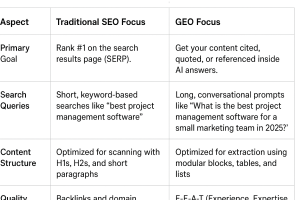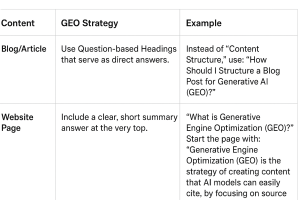Generative Engine Optimization (GEO): The New SEO for AI Search
Generative Engine Optimization (GEO): The New SEO for AI Search
As AI search grows, Generative Engine Optimization (GEO) is becoming the new rule for writers and marketers. GEO means creating content that AI tools like ChatGPT, Google AI Overviews, or Perplexity can easily understand, extract, and cite as a trusted source.
Unlike traditional SEO, where the goal is to rank #1 on Google, GEO focuses on getting your content mentioned in AI-generated answers. It’s about being referenced, not just ranked.

Top GEO Writing Strategies
- Write for Conversational Prompts:
Use question-style headings like “How Should I Structure a Blog for GEO?” Add short summary answers at the top for clarity. - Use Extractable Structures:
Write in short paragraphs, numbered lists, or tables (for example, “GEO vs. SEO vs. AEO”). AI tools can easily pull this data. - Boost E-E-A-T and Source Clarity:
Quote reliable sources with data, include a strong author bio (e.g., “John Smith, MBA, 10+ Years in B2B SaaS Strategy”), and use FAQPage or HowTo schema to help AI read your site better.

Vithusha, this is a really good break down!
GEO indeed is redefining the way we think of content strategy, it is no longer a matter of ranking but about being accessable and quotable by AI systems.
It will be interesting to watch how the brands will proceed to optimize their content to both humans and AI models simultaneously, the next step in the evolution of SEO + UX.
I have recently written a blog post, in which I have discussed some SEO tips to optimize the content to rank in AI Search Results.
You can find the article here: https://bit.ly/4hsz6gq

